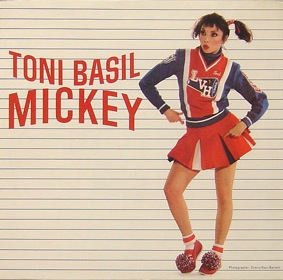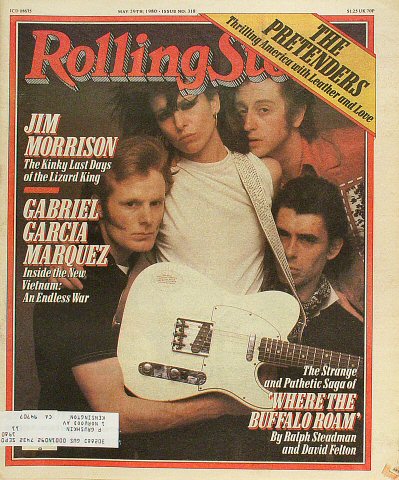
Everybody loved Sweet, the British boys who turned the corner from glam to power pop with "Ballroom Blitz" and "Little Willy." The masterminds behind Sweet were the writing/producing team of Nicky Chinn and Mike Chapman. When Sweet decided they wanted a harder-edged sound, they turned away from Chinn and Chapman, who went on to write "Stumblin' In" for Suzi "Leather Tuscadero" Quatro and "Kiss You All Over" for Exile.
The duo also wrote a song for a British pop combo named Racey, called "Kitty," released on the 1979 album Smash and Grab. Racey had a few hits in England, but nothing over here in the U.S.
But let's leave Racey for the moment and take the story back to 1961 and over to Las Vegas, where Louis Basil has recently moved his family from Chicago in order to become the bandleader for the house orchestra at the Sahara Hotel, and his daughter Toni (born Antonia Basilotta) is about to graduate from Las Vegas High School, where she has been head cheerleader. "There's nothing better than being head cheerleader, let me tell you," she said last year, and I don't doubt her for a second. Toni's mom was in Wells & the Four Fays, an acrobatic comedy act that appeared on The Ed Sullivan Show the same night as the Beatles.
After leaving high school, Toni headed to Los Angeles, and by 1964, she had landed a job as an assistant choreographer on a new pop-music show called Shindig. (One of her dancers, who became a good friend, was Teri Garr.) Toni appeared as a go-go dancer in the 1964 film The T.A.M.I. Show, which led to appearances in such movies as Head, Easy Rider and Five Easy Pieces. In 1966, she cut a single, the title song to the experimental film Breakaway, in which she also danced. (It's not the same song as the later Art Garfunkel classic.) Breakaway has been removed from all the customary Internet outlets, so I haven't seen it, but I have it on good authority that Toni appears very naked in it.
In the early 1970s, Basil worked with David Bowie on his Diamond Dogs tour, but left that behind for a while to found and dance with a street troupe called the Lockers, who generally consisted of five or six black dudes (including the late Fred "Rerun" Berry) and Toni Basil. The Lockers got a slot dancing on one of the first episodes of Saturday Night Live, then, for reasons that remain obscure to me, Toni was asked back later in the first season to sing a song called "Wham Re-Bop Boom Bam." She didn't have an album out, or a single, and as far as I can tell, she hadn't sung professionally since 1966. Go figure.
Later on, she conceived and choreographed a short film, directed by Gary Weis, for SNL that featured members of the Lockers dancing Swan Lake with some ballerinas. Toni wanted to do, for her next video, something with cheerleaders dancing and chanting, coincidentally right about the same time that a British label exec named Simon Lait met her in Los Angeles and thought he could turn her into a pop star. Lait went to his friend Nicky Chinn to see if he could get a song for his fledgling star, and Chinn suggested "Kitty."
Basil liked the song and thought it would work even better with the cheerleaders' chant appended on to it. (The cheerleaders were from Dorsey High School in Los Angeles, class of '81.) She changed the title to "Mickey," both because it rhymed with "Kitty" and because she had developed a crush on Micky Dolenz while making Head. None of the other lyrics were changed, so "Any way you wanna do it, I'll take it like a man" had a different, less racy meaning in the Racey version. Basil recorded the song in 1980 and directed the video, in which she appeared in the same cheerleaders' outfit she wore back at Las Vegas High School. (She is very proud to say that she still, to this day, at the age of 65, fits into that uniform.)
When the BBC saw the video, it asked Basil to make her own TV special around it. That helped push "Mickey" to Number Two in the U.K.; the single was released here on October 5, 1982, around the same time as her album Word of Mouth (I have had a very hard time tracking down the release date for the album), which featured a couple of Devo covers and several members of Devo playing on it. (Toni was involved with Devo bassist and designer Jerry Casale at the time.) "Mickey" immediately leapt into the Top Forty the first week it was released, and on December 11, 1982, it replaced Lionel Richie's "Truly" as the Number One song in America.
Toni released a second album, Toni Basil, in 1983, with three more Devo covers, but none of them made any kind of a splash, although "Over My Head" won an MTV Video Award. Basil went back to her day job, choreographing David Byrne's herky-jerky dance for the "Once in a Lifetime" video and those great Gap commercials with all that bossa nova style dancing in them. (She has estimated that, since 1982, "Mickey" has earned her the grand sum of $3,000 in royalties.) She's now choreographing Bette Midler's Las Vegas revue.
I can't find the original cheerleading version of "Mickey" online, although Toni will have you know it's in the Musuem of Modern Art. But this is a mini-documentary synced up to that video, and it'll do:





